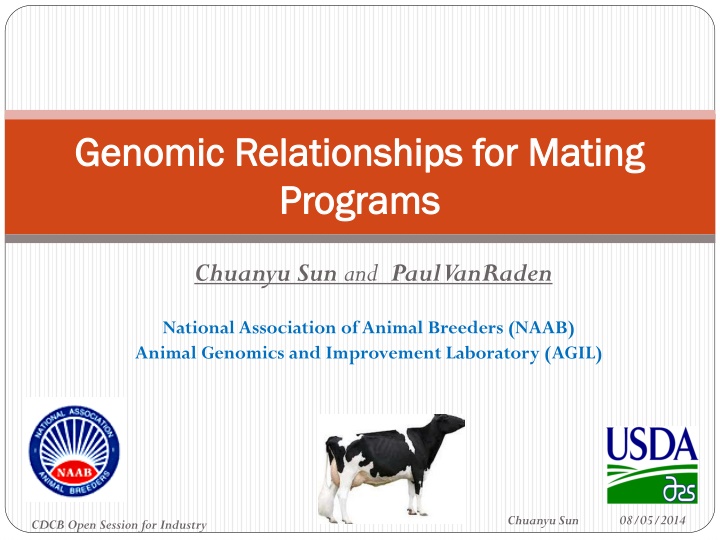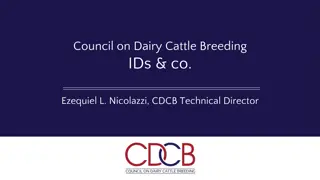
Genomic Relationships for Mating Programs in Animal Breeding
Discover the significance of genomic relationships in mating programs for animal breeders, utilizing computerized tools to reduce inbreeding and enhance breeding values. Learn how pedigree and genomic relationships are crucial in selecting optimal mating pairs. Explore the implementation of new programs to minimize genomic inbreeding and improve breeding outcomes.
Download Presentation

Please find below an Image/Link to download the presentation.
The content on the website is provided AS IS for your information and personal use only. It may not be sold, licensed, or shared on other websites without obtaining consent from the author. If you encounter any issues during the download, it is possible that the publisher has removed the file from their server.
You are allowed to download the files provided on this website for personal or commercial use, subject to the condition that they are used lawfully. All files are the property of their respective owners.
The content on the website is provided AS IS for your information and personal use only. It may not be sold, licensed, or shared on other websites without obtaining consent from the author.
E N D
Presentation Transcript
Genomic Relationships for Mating Genomic Relationships for Mating Programs Programs Chuanyu Sun and Paul VanRaden National Association of Animal Breeders (NAAB) Animal Genomics and Improvement Laboratory (AGIL) Chuanyu Sun 08/05/2014 CDCB Open Session for Industry
Introduction Introduction Computerized mating programs have helped breeders reduce pedigree inbreeding by identifying matings between animals with fewer ancestors in common than average In genomic era, dense single nucleotide polymorphism (SNP) markers across the whole genome have been widely used for genomic selection Pedigree relationship Genomic relationship
Introduction Introduction Pedigree relationship The expected relationship 40925026 00000021111120022002111011111201110101111001 52110921 2000200101001120220021100201200012212001120 54304711 2100002021102002200200002202020220022200200 Genomic relationship The realized relationship
Introduction Introduction Inbreeding should be controlled on the same basis as used to estimate breeding values (Sonesson et al. 2012) Pedigree-based inbreeding control with traditional pedigree- based method estimated breeding values Genome-based inbreeding control with genome-based estimated breeding values New programs to minimize genomic inbreeding by comparing genotypes of potential mates should be developed and implemented by breed associations, AI organizations, and on-farm software providers
Genomic relationship Genomic relationship The Genomic relationship file given bulls and cows ID is ready to create routinely by CDCB since Aug, 2014 This file includes all the genotyped females and a list of bulls
Genomic relationship Genomic relationship Which bulls were included ? HO: The 3,300 potential sires are: 800 A - Active bulls 500 I Inactive bulls that breeders are still using 1000 G - Genomic young sire semen being marketed. 1000 C - High Ranking Elite sires Collected but not yet made available 1. Within each category, bulls would be sorted by NM$ with the highest ones taken first 2. Extra criteria: the top 500 Inactive bulls would also need to have a minimum production and type reliability of at least 95%. This way is to ensure that we are selecting the popular Inactive bulls. 3. Other breeds limit reliability >90%
Genomic relationship Genomic relationship Each approved CDCB member organization would receive their own copy of the file One breed one file The CDCB would create the large file 3 times per year. Then at each monthly genomic update, providing a monthly update file for new females with the Previously identified bulls
How to earn benefit How to earn benefit Mating strategies
How to earn benefit How to earn benefit Mean expect progeny values (EPV) n + + + ) ] 100(0.5) j (GLNM GLNM ) [(EFI EFI [( ) ] j LNM B LNM B sire,dam G sire dam sire dam j = 1 j n GLNM is Genomic lifetime net merit BLNM is defined as the loss of LNM per 1% inbreeding, BLNM=$23.11 EFI is expected future inbreeding, Gsire,dam is the genomic relationship between sire and dam
How to earn benefit How to earn benefit Mating strategies bulls females EPVij Random mating (RD) Sequential selection of least-related mates (SM) Linear programming (LP)
How to earn benefit How to earn benefit Example data Mating programs Brown Swiss Jersey Holstein Males females 8 79 50 500 50 500
How to earn benefit How to earn benefit Example data increased Progeny values Mate Inbreeding source Genomic Pedigree Genomic Pedigree EPV2 ($) Holstein 494 462 474 450 422 393 363 372 350 314 70 40 70 40 36 21 39 24 Selected bulls Top 50 for genomic LNM Mating method Linear programming Brown Swiss 205 184 181 175 138 158 136 127 124 107 64 43 64 45 37 27 32 22 0 Jersey 358 326 333 312 255 307 274 278 263 214 78 42 78 41 46 29 46 27 0 Sequential least-related3 Random Linear programming Top 50 for traditional LNM Genomic Pedigree Genomic Pedigree Sequential least-related2 Random Linear programming Random 50 Genomic Pedigree Genomic Pedigree Genomic Pedigree Genomic Pedigree Sequential least-related2 Random 0 2Relative to randomly selected bulls that were randomly mated 3Pryce et al. (2012)
How to earn benefit How to earn benefit Example data reducing progeny inbreeding Mate Inbreeding source Genomic Pedigree Genomic Pedigree Progeny inbreeding (%) Brown Swiss 6.94 7.87 7.97 8.27 9.83 6.11 7.07 7.45 7.60 8.36 6.64 7.56 6.64 7.49 7.83 8.26 8.05 8.47 9.30 Selected bulls Top 50 for genomic LNM Mating method Linear programming Holstein 5.17 6.58 6.03 7.09 8.31 4.87 6.15 5.79 6.72 8.30 4.46 5.77 4.46 5.78 5.97 6.58 5.84 6.48 7.51 Jersey 3.72 5.12 4.78 5.70 8.17 3.41 4.82 4.66 5.32 7.43 3.65 5.22 3.65 5.26 5.04 5.76 5.05 5.86 7.04 Sequential least-related Random Linear programming Top 50 for traditional LNM Genomic Pedigree Genomic Pedigree Sequential least-related Random Linear programming Random 50 Genomic Pedigree Genomic Pedigree Genomic Pedigree Genomic Pedigree Sequential least-related Random
How to earn benefit How to earn benefit Example data summaries Expected progeny value was higher when genomic rather than pedigree relationship was used as the mate inbreeding source. 1. Expected progeny value was higher for linear programming than the sequential method, and both of those methods were better than random mating. 2. Expected progeny value was higher when top 50 mated bulls were selected based on genomic LNM rather than traditional LNM or random. 3. Mean genomic inbreeding of progeny was lowest when genomic relationship was used other than pedigree relationship 4. LP is better than SM and RD on control inbreeding of progeny 5.
How to earn benefit How to earn benefit Total annual value (based on Oct, 2012 data): Mate Inbreeding source EPV ($) Holstein 494 462 474 450 422 Selected bulls Top 50 for genomic LNM Mating method Linear programming Brown Swiss Jersey Genomic 205 358 Pedigree 184 181 175 138 326 333 312 255 Sequential least-related3 Genomic Pedigree Random ($494 - $462)(120989) = $3,871,648 Only by replacing Pedigree relationship using Genomic relationship
How to earn benefit How to earn benefit Economic benefits will continue to grow as more females are genotyped 400000 Number of Genotyped Female 350000 300000 >=50K 250000 <50k 200000 150000 100000 50000 0 1012 1112 1212 1312 1006 1008 1010 1102 1104 1106 1108 1110 Genomic Evaluation Date 1202 1204 1206 1208 1210 1302 1304 1306 1308 1310 1402 1404 1406 ($494 - $462)(249877 ) = $7,996,064
Software Implement Software Implement Genomic relationship Linear programming GLPK http://www.gnu.org/software/glpk/ Rglpk http://cran.r-project.org/web/packages/Rglpk/index.html lpSolve http://cran.r-project.org/web/packages/lpSolve/index.html Rsymphony http://cran.r-project.org/web/packages/Rsymphony/index.html n + + + ) ] 100(0.5) j (GLNM GLNM ) [(EFI EFI [( ) ] j LNM B LNM B sire,dam G sire dam sire dam j = 1 j n
Software Implement Software Implement Available The matingProgram package includes two executable files: matingProgram_S1 matingProgram_S2 This package performs 3 functions: I. Create relationship files given bulls ID and female ID II. Create relationship and mating plans files given bulls ID and female ID III. Make mating plans given bulls ID, female ID and relationship file
Software Implement Software Implement Inputs HOUSA000069981349 HOUSA000069560690 HOUSA000070625846 HOUSA000064633877 HOUSA000053668601 Outputs HOUSA000134954851 HOUSA000061834459 HOUSA000061839286 HOUSA000061845599 HOUSA000061845646 HOUSA000061845655 HOUSA000061845681 HOUSA000061845689 HOUSA000061845706 HOUSA000061845722 HOUSA00035SHE7944 HOUSA00035SHE7943 HOUSA00035SHE7948 HOUSA00035SHE7949
Discussions Discussions Type trait I. Nonlinear merit function M=c + a G + bG2 (b<0) II. Intrabreed Mating Pair Selection Methods for Improvement of Nonlinear Merit from Additive Genetic Inheritance: A Review F.R. Allaire Volume 76: 2308 2319, 1993 III. Different approach to assign optimized mating pair Including dominance effect in mating program to earn extra benefit

